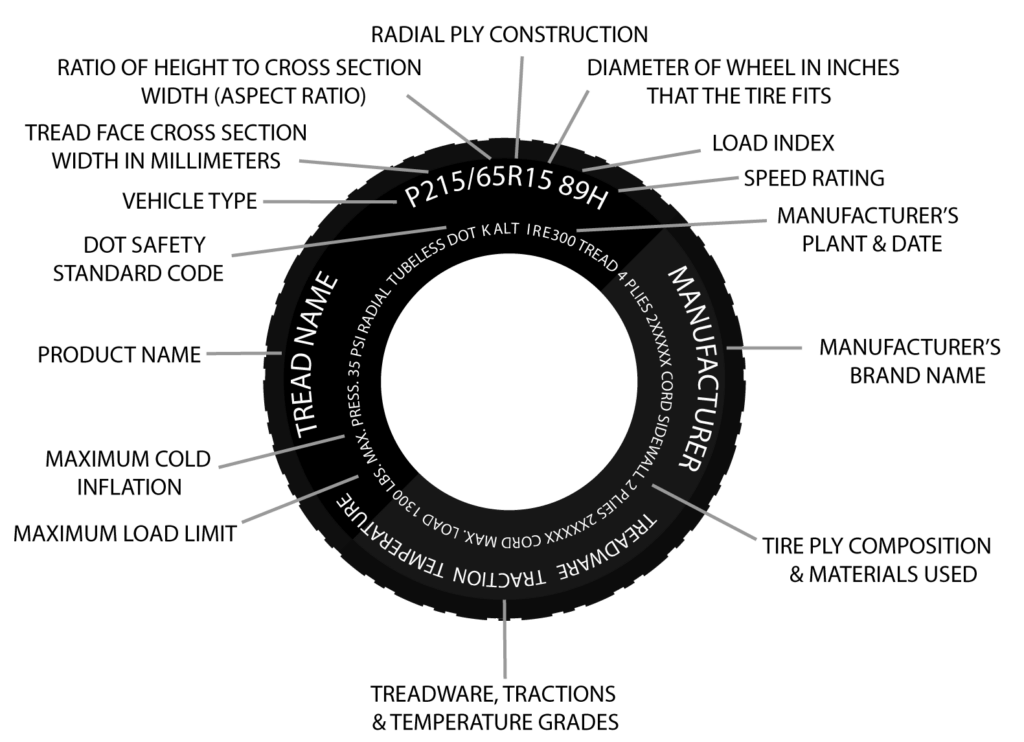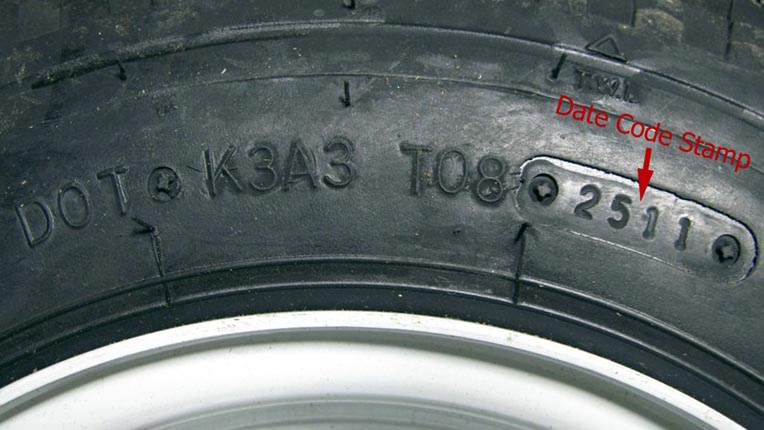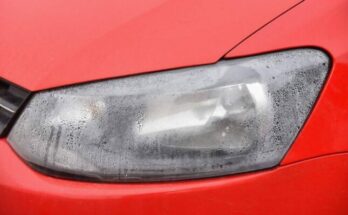Tires carry a lot of information on their sidewalls; unfortunately, it’s all in code. In addition to the tire’s brand and tire model, there is a lot of information provided by the manufacturer on the sidewalls of the tires they produce. This information includes the tire’s basic dimensions and identifies when it was produced, the types of materials used internally to reinforce the rubber, along with the tire’s maximum inflation pressures and loads etc.
Consider an example if we have a tire which reads P215/65 R15 89H on its sidewall, the reading would mean:
VEHICLE CLASS – P215/65R15 89H
The first alphabet represents the class of the vehicle, though not all tires include this letter.
P: Passenger Car
LT: Light Truck
SP: Special Trailer
T: Temporary (restricted usage for ‘Space-Saver’ spare wheels)
3 DIGIT NUMBER – P215/65R15 89H
The ‘nominal section width’ of the tire in millimeters; the widest point from both outer edges of a tire.
2 OR 3 DIGIT NUMBER – P215/65R15 89H
The ‘aspect ratio’ of the sidewall height to the total width of the tire, as a percentage. If no information is provided, it is assumed to be 82%. If the number is larger than 200, then this is the diameter of the entire tire in millimeters.
AN OPTIONAL LETTER – P215/65R15 89H
Indicating construction of the fabric carcass of the tire.
B: Bias belt
D: Diagonal
R: Radial
2 DIGIT NUMBER – P215/65R15 89H
The wheel diameter, in inches, that the tire will fit.
2 OR 3 DIGIT NUMBER – P215/65R15 89H
The load index is the tire size’s assigned numerical value used to compare relative load carrying capabilities. In the case of our example the number 89 identifies the tires ability to carry approximately 580 kg of weight. The higher the tire’s load index number, the greater its load carrying capacity.
| Load Index | Pounds | Kilograms | Load Index | Pounds | Kilograms | |
| 71 | 761 | 345 | 91 | 1356 | 615 | |
| 72 | 783 | 355 | 92 | 1389 | 630 | |
| 73 | 805 | 365 | 93 | 1433 | 650 | |
| 74 | 827 | 375 | 94 | 1477 | 670 | |
| 75 | 853 | 387 | 95 | 1521 | 690 | |
| 76 | 882 | 400 | 96 | 1565 | 710 | |
| 77 | 908 | 412 | 97 | 1609 | 730 | |
| 78 | 937 | 425 | 98 | 1653 | 750 | |
| 79 | 963 | 437 | 99 | 1709 | 775 | |
| 80 | 992 | 450 | 100 | 1764 | 800 | |
| 81 | 1019 | 462 | 101 | 1819 | 825 | |
| 82 | 1047 | 475 | 102 | 1874 | 850 | |
| 83 | 1074 | 487 | 103 | 1929 | 875 | |
| 84 | 1102 | 500 | 104 | 1984 | 900 | |
| 85 | 1135 | 515 | 105 | 2039 | 925 | |
| 86 | 1168 | 530 | 106 | 2094 | 950 | |
| 87 | 1201 | 545 | 107 | 2149 | 975 | |
| 88 | 1235 | 560 | 108 | 2205 | 1000 | |
| 89 | 1279 | 580 | 109 | 2271 | 1030 | |
| 90 | 1323 | 600 | 110 | 2337 | 1060 |
1 OR 2 DIGIT/LETTER COMBO – P215/65R15 89H
Represents the speed rating. The speed rating code is made up of either one or two letters, or one letter and one number. It indicates the maximum permitted speed that the tire can sustain for 10 minute endurance without being in danger. Considering the above example, the H rating means the tires can sustain a 10 minute endurance at a maximum speed of 210 km/h. Tires with a speed rating higher than 300 km/h include a ‘Y’ in parenthesis. The load rating is often included within the parenthesis, e.g. (86Y).
| Speed Symbol | Maximum speed (km/h) |
| N | 140 |
| P | 150 |
| Q | 160 |
| R | 170 |
| S | 180 |
| T | 190 |
| U | 200 |
| H | 210 |
| V | 240 |
| Z | 240 |
| W | 270 |
| Y | 300 |
RIM WIDTHS
The allowable range of rim widths for a specific tire size, running a tire on a rim size or type not approved by its manufacturer can result in tire failure and a loss of vehicle control.
MANUFACTURING INFO
It specifies the company, factory, mold, batch, and date of production (2 digits for week of the year plus 2 digits for year). For example, if the last four digits of the code are 2511, that means that the tire was manufactured during the 25th week of the year 2011.
ADDITIONAL MARKS
There can be numerous other markings on a typical tire, these may include:
- M+S, or M&S: Mud and Snow; all-weather tires, with above-average traction in muddy or very light snowy conditions, and for low ambient temperatures. Not classified as a winter tire unless it has the snowflake and mountain symbol. Studded tires have an additional letter, ‘E’ (M+SE).
- BSW: Black Sidewall
- WSW: White Sidewall
- OWL: Outline White Lettering
- VSB: Vertical Serrated Band
- TL: Tubeless
- TT: Tube-type, tire must be used with an inner-tube
- C: Commercial; tires for light
- LL: Light Load; tires for light usage and loads
- SL: Standard Load; tire for normal usage and loads
- XL: Extra Load; tire for vehicles of heavier standard weights
- RF: Reinforced tires

A computer animation professional with over 23 years of industry experience having served in leading organizations, TV channels & production facilities in Pakistan. An avid car enthusiast and petrolhead with an affection to deliver quality content to help shape opinions. Formerly written for PakWheels as well as major publications including Dawn. Founder of CarSpiritPK.com






